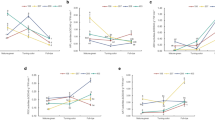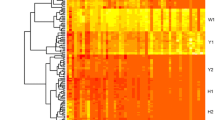Abstract
Introduction
The process of tomato (Solanum lycopersicum) breeding has affected negatively the fruit organoleptic properties and this is evident when comparing modern cultivars with heirloom varieties. Flavor of tomato fruit is determined by a complex combination of volatile and nonvolatile metabolites that is not yet understood.
Objectives
The aim of this work was to provide an alternative approach to exploring the relationship between tomato odour/taste and volatile organic compounds (VOCs).
Methods
VOC composition and organoleptic properties of seven Andean tomato landraces along with an edible wild species (Solanum pimpinellifolium) and four commercial varieties were characterized. Six hedonic traits were analyzed by a semitrained sensory panel to describe the organoleptic properties. Ninety-four VOCs were analyzed by headspace solid phase microextraction/gas chromatography–mass spectrometry (HS/SPME/GC–MS). The relationship between sensory data and VOCs was explored using an Artificial Neural Networks model (Kohonen Self Organizing Maps, omeSOM).
Results and Conclusion
The results showed a strong preference by panelists for tomatoes of landraces than for commercial varieties and wild species. The predictive analysis by omeSOM showed 15 VOCs significantly associated to the typical and atypical tomato odour and taste. Moreover, omeSOM was used to predict the relationship of VOC ratios with sensory data. A total of 108 VOC ratios out of 8837 VOC ratios were predicted to be contributing to the typical and atypical tomato odour and taste. The metabolic origin of these flavor-associated VOCs and the metabolic point or target for breeding strategies were discussed.





Similar content being viewed by others
References
Asprelli, P. D., Occhiuto, P. N., Makuch, M. A., Lorello, I. M., Togno, L. S., García, S. C., et al. (2011). Recolección de germoplasma criollo de especies cultivadas y su distribución en regiones andinas de Argentina. Horticultura Argentina, 30(71), 30–45.
Asprelli, P. D., Sance, M., Insani, E. M., Asis, R., Valle, E. M., Carrari, F., et al. (2017). Agronomic performance and fruit nutritional quality of an Andean tomato collection. In XIV international symposium on processing tomato (Vol. 1159, pp. 197–204) https://doi.org/10.17660/ActaHortic.2017.1159.29.
Bai, Y., & Lindhout, P. (2007). Domestication and breeding of tomatoes: What have we gained and what can we gain in the future? Annals of Botany, 100(5), 1085–1094.
Baldwin, E. A., Goodner, K., & Plotto, A. (2008). Interaction of volatiles, sugars, and acids on perception of tomato aroma and flavor descriptors. Journal of Food Science, 73, S294–S307.
Baldwin, E. A., Scott, J. W., Einstein, M. A., Malundo, T. M. M., Carr, B. T., Shewfelt, R. L., et al. (1998). Relationship between sensory and instrumental analysis for tomato flavor. Journal of the American Society for Horticultural Science, 123(5), 906–915.
Bauchet, G., Grenier, S., Samson, N., Segura, V., Kende, A., Beekwilder, J., et al. (2017). Identification of major loci and genomic regions controlling acid and volatile content in tomato fruit and implications for flavor improvement. New Phytologist, 215(2), 624–641.
Bergougnoux, V. (2014). The history of tomato: From domestication to biopharming. Biotechnology Advances, 32(1), 170–189.
Buttery, R. G., & Ling, L. C. (1993). Volatile components of tomato fruit and plant parts: Relationship and biogenesis. In R. Teranishi, R. G. Buttery & H. Sugisawa (Eds.), Bioactive volatile compounds from plants (pp. 22–33). ACS: Washington, D.C.
Cortina, P. R., Asis, R., Peralta, I. E., Asprelli, P. D., & Santiago, A. N. (2017). Determination of volatile organic compounds in Andean tomato landraces by headspace solid phase microextraction-gas chromatography-mass spectrometry. Journal of the Brazilian Chemical Society, 28(1), 30–41.
Di Rienzo, J. A., Guzmán, A. W., & Casanoves, F. (2002). A multiple-comparisons method based on the distribution of the root node distance of a binary tree. Journal of Agricultural, Biological, and Environmental Statistics, 7(2), 129–142.
Dorais, M., Ehret, D., & Papadopoulos, A. (2008). Tomato (Solanum lycopersicum) health components: From the seed to the consumer. Phytochemistry Reviews, 7(2), 231–250.
Everitt, B., Landau, S., Leese, M., & Stahl, D. (2011). Cluster analysis (5th ed.). Wiley: Chichester.
Goff, S. A., & Klee, H. J. (2006). Plant volatile compounds: Sensory cues for health and nutritional value? Science, 311, 815–819.
Goulet, C., Kamiyoshihara, Y., Lam, N. B., Richard, T., Taylor, M. G., Tieman, D. M., et al. (2015). Divergence in the enzymatic activities of a tomato and Solanum pennellii alcohol acyl transferase impacts fruit volatile ester composition. Molecular Plant, 8(1), 153–162.
Goulet, C., Mageroy, M. H., Lam, N. B., Floystad, A., Tieman, D. M., et al. (2012). Role of an esterase in flavor volatile variation within the tomato clade. Proceedings of the National Academy of Sciences of the United States of America, 109(46), 19009–19014.
Hübschmann, H. J. (2009). Handbook of GC/MS: Fundamentals and applications. Weinheim: Wiley.
Klee, H. J. (2010). Improving the flavor of fresh fruits: Genomics, biochemistry, and biotechnology. New Phytologist, 187(1), 44–56.
Klee, H. J., & Tieman, D. M. (2013). Genetic challenges of flavor improvement in tomato. Trends in Genetics, 29(4), 257–262.
Koeduka, T., Fridman, E., Gang, D. R., Vassão, D. G., Jackson, B. L., Kish, C. M., et al. (2006). Eugenol and isoeugenol, characteristic aromatic constituents of spices, are biosynthesized via reduction of a coniferyl alcohol ester. Proceedings of the National Academy of Sciences of the United States of America, 103(26), 10128–10133.
Lewinsohn, E., Sitrit, Y., Bar, E., Azulay, Y., Meir, A., Zamir, D., et al. (2005). Carotenoid pigmentation affects the volatile composition of tomato and watermelon fruits, as revealed by comparative genetic analyses. Journal of Agricultural and Food Chemistry, 53(8), 3142–3148.
Milone, D. H., Stegmayer, G., Kamenetzky, L., López, M., & Carrari, F. (2013). Clustering biological data with SOMs: On topology preservation in non-linear dimensional reduction. Expert Systems with Applications, 40(9), 3841–3845.
Milone, D. H., Stegmayer, G. S., Kamenetzky, L., Lopez, M., Lee, J. M., Giovannoni, J. J., et al. (2010). *omeSOM: A software for clustering and visualization of transcriptional and metabolite data mined from interspecific crosses of crop plants. BMC Bioinformatics, 11, 438.
Occhiuto, P. N., Peralta, I. E., Asprelli, P. D., & Galmarini, C. R. (2014). Characterization of capsicum germplasm collected in northwestern argentina based on morphological and quality traits. AgriScientia, 31(2), 63–73.
Peralta, I. E., Makuch, M., García Lampasona, S., Occhiuto, P. N., Asprelli, P. D., Lorello, I. M., & Togno, L. (2008). Catalogo de Poblaciones Criollas de Pimiento, Tomate y Zapallo colectadas en Valles Andinos de la Argentina (pp. 52–99). Mendoza: Instituto Nacional de Tecnología Agropecuaria.
Peralta, I. E., & Spooner, D. M. (2007). History, origin and early cultivation of tomato (Solanaceae). In M. K. Razdan & A. K. Mattoo (Eds.), Genetic improvement of Solanaceous crops, Vol. 2: Tomato (pp. 1–27). Enfield: Science Publishers.
Petro-Turza, M. (1986). Flavor of tomato and tomato products. Food Reviews International, 2(3), 309–351.
Piombino, P., Sinesio, F., Moneta, E., Cammareri, M., Genovese, A., Lisanti, M. T., et al. (2013). Investigating physicochemical, volatile and sensory parameters playing a positive or a negative role on tomato liking. Food Research International, 50(1), 409–419.
Rambla, J. L., Tikunov, Y. M., Monforte, A. J., Bovy, A. G., & Granell, A. (2014). The expanded tomato fruit volatile landscape. Journal of Experimental Botany, 65(16), 4613–4623.
Singh, R., Rastogi, S., & Dwivedi, U. N. (2010). Phenylpropanoid metabolism in ripening fruits. Comprehensive Reviews in Food Science and Food Safety, 9(4), 398–416.
Stegmayer, G., Milone, D. H., Kamenetzky, L., Lopez, M., & Carrari, F. (2009). Neural network model for integration and visualization of introgressed genome and metabolite data. In IEEE international joint conference on neural networks (pp. 2983–2989) Atlanta: IEEE.
Tadmor, Y., Fridman, E., Gur, A., Larkov, O., Lastochkin, E., Ravid, U., et al. (2002). Identification of malodorous, a wild species allele affecting tomato aroma that was selected against during domestication. Journal of Agricultural and Food Chemistry, 50(7), 2005–2009.
Tandon, K. S., Baldwin, E. A., Scott, J. W., & Shewfelt, R. L. (2003). Linking sensory descriptors to volatile and nonvolatile components of fresh tomato flavor. Journal of Food Science, 68(7), 2366–2371.
Tandon, K. S., Baldwin, E. A., & Shewfelt, R. L. (2000). Aroma perception of individual volatile compounds in fresh tomatoes (Lycopersiconesculentum, Mill.) as affected by the medium of evaluation. Postharvest Biology and Technology, 20, 261–268.
Tanksley, S. D., & McCouch, S. R. (1997). Seed banks and molecular maps: Unlocking genetic potential from the wild. Science, 277(5329), 1063–1066.
Tieman, D., Taylor, M., Schauer, N., Fernie, A. R., Hanson, A. D., & Klee, H. J. (2006). Tomato aromatic amino acid decarboxylases participate in synthesis of the flavor volatiles 2-phenylethanol and 2-phenylacetaldehyde. Proceedings of the National Academy of Sciences of the United States of America, 103(21), 8287–8292.
Tieman, D., Zeigler, M., Schmelz, E., Taylor, M. G., Rushing, S., Jones, J. B., et al. (2010). Functional analysis of a tomato salicylic acid methyl transferase and its role in synthesis of the flavor volatile methyl salicylate. The Plant Journal, 62(1), 113–123.
Tieman, D. M., Bliss, P., McIntyre, L. M., Blandon-Ubeda, A., Bies, D., Odabasi, A. Z., et al. (2012). The chemical interactions underlying tomato flavor preferences. Current Biology, 22, 1035–1039.
Tieman, D. M., Loucas, H. M., Kim, J. Y., Clark, D. G., & Klee, H. J. (2007). Tomato phenylacetaldehyde reductases catalyze the last step in the synthesis of the aroma volatile 2-phenylethanol. Phytochemistry, 68(21), 2660–2669.
Tieman, D. M., Zhu, G., Resende, M. F. R., Lin, T., Nguyen, C., Bies, D., et al. (2017). A chemical genetic roadmap to improved tomato flavor. Science, 355, 6323–6391.
Tikunov, Y., Lommen, A., De Vos, C. H. R., Verhoeven, H. A., Bino, R. J., Hall, R. D., et al. (2005). A novel approach for non targeted data analysis for metabolomics large-scale profiling of tomato fruit volatiles. Plant Physiology, 139(3), 1125–1137.
Tsugawa, H., Tsujimoto, Y., Arita, M., Bamba, T., & Fukusaki, E. (2011). GC/MS based metabolomics: Development of a data mining system for metabolite identification by using soft independent modeling of class analogy (SIMCA). BMC Bioinformatics, 12, 131.
Van Meulebroek, L., Bussche, J., De Clercq, N., Steppe, K., & Vanhaecke, L. (2015). A metabolomics approach to unravel the regulating role of phytohormones towards carotenoid metabolism in tomato fruit. Metabolomics, 11(3), 667–683.
Vogel, J. T., Tieman, D. M., Sims, C. A., Odabasi, A. Z., Clark, D. G., & Klee, H. J. (2010). Carotenoid content impacts flavor acceptability in tomato (Solanum lycopersicum). Journal of the Science of Food and Agriculture, 90(13), 2233–2240.
Zanor, M. I., Rambla, J., Chaïb, J., Steppa, A., Medina, A., Granell, A., et al. (2009). Metabolic characterization of loci affecting sensory attributes in tomato allows an assessment of the influence of the levels of primary metabolites and volatile organic contents. Journal of Experimental Botany, 60(7), 2139–2154.
Acknowledgements
The authors would like to acknowledge the sensory panel (Facultad de Agronomia, Universidad Nacional de Cuyo) and Georgina Stegmayer and Diego Milone for technical assistance in omeSOM analysis.
Funding
This study was funded in part by ANPCyT (PICT 2007-1942), CONICET, SECYT-UNC, INTA and the European Union Horizon 2020 Research and Innovation Programme, Grant Agreement Number 679796.
Author information
Authors and Affiliations
Corresponding author
Ethics declarations
Conflict of interest
All authors declare that they have no conflict of interest.
Ethical approval
The sensory study was approved by the committee of the food science department of the National University of Cuyo. This committee established ethical criteria and protocols for sensorial panels to evaluate fresh and processing products based on the legislation provided by the National Administration of Medicine, Food and Medical Technology of Argentina (ANMAT) and National Food Code.
Electronic supplementary material
Below is the link to the electronic supplementary material.
11306_2018_1355_MOESM1_ESM.tif
Fig. S1. Map 30×30 of VOC ratios and sensory data. Grey and dark grey squares represent neurons with metabolites and sensory variables, respectively. Black square represent neurons with both variables. Sizes square represent the amount of variables inside the neurons. (TIF 1974 KB)
Rights and permissions
About this article
Cite this article
Cortina, P.R., Santiago, A.N., Sance, M.M. et al. Neuronal network analyses reveal novel associations between volatile organic compounds and sensory properties of tomato fruits. Metabolomics 14, 57 (2018). https://doi.org/10.1007/s11306-018-1355-7
Received:
Accepted:
Published:
DOI: https://doi.org/10.1007/s11306-018-1355-7




